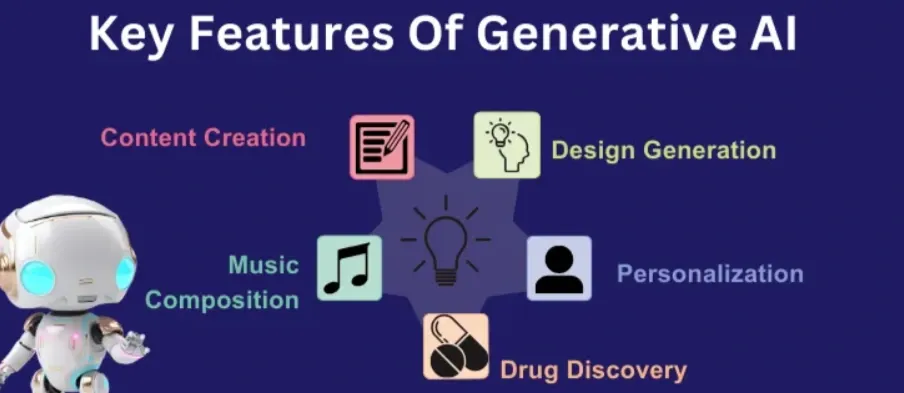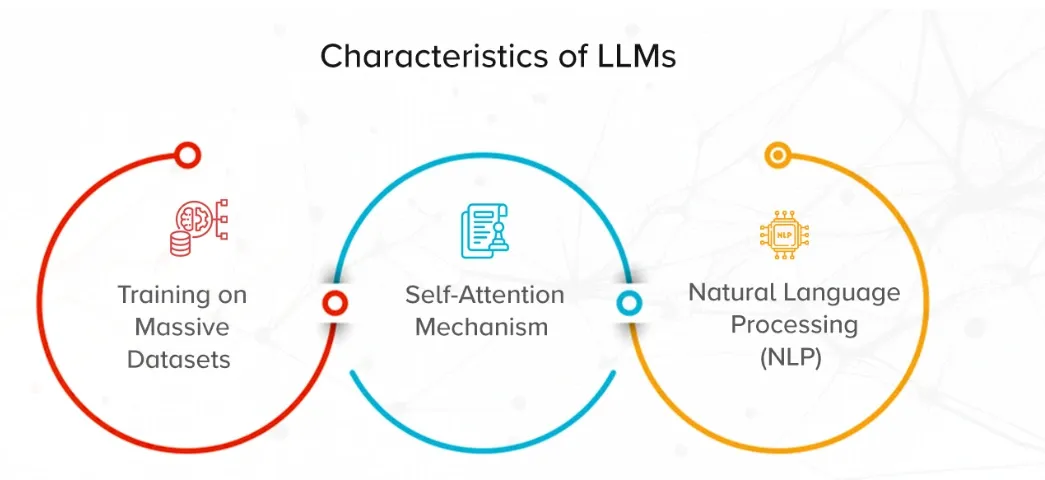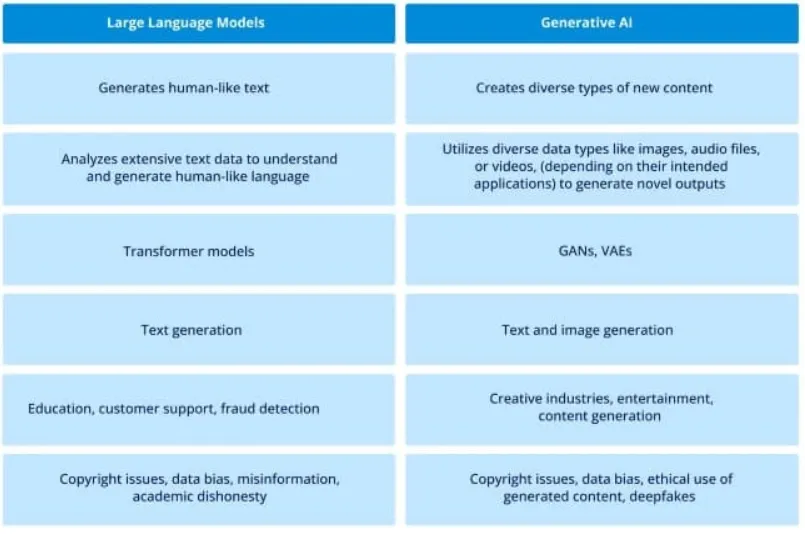Introduction
Whether to leverage large language models (LLMs) or venture into the realm of Generative AI. This generative AI vs LLM has become increasingly pressing, as both technologies offer unique capabilities and promise to transform various industries.
According to a 2023 report by Grand View Research, the global Generative AI market is expected to grow at a CAGR of 34.6% from 2023 to 2030, reaching a staggering value of $110.3 billion.
Concurrently, a study by McKinsey & Company revealed that the adoption of LLMs across organizations has surged, with 58% of executives indicating that their companies have already implemented or are piloting these advanced language models.
This begs the question: generative AI vs LLM – which is the right tool for your business? Understanding the nuances between these two cutting-edge technologies, their respective strengths, and their applications, is crucial for organizations seeking to harness the power of AI and drive strategic innovation.
Understanding Generative AI
Generative AI refers to systems capable of generating content, such as text, images, music, and even videos. Unlike traditional AI, which follows predefined rules, Generative AI models learn from vast amounts of data to create new, original content.
Text Generation: Generative AI can write articles, stories, or even poetry. For instance, news agencies use Generative AI to draft reports on routine subjects, freeing journalists to focus on complex stories.

Image Creation: Artists use AI tools to generate artwork based on specific styles or themes. A notable example is AI-generated art exhibitions where the artworks are entirely created by Generative AI systems.
Music Composition: Musicians can employ AI to compose new pieces. An example is an AI that creates background scores for films, tailoring the music to match the mood of different scenes.
Key Features of Generative AI

Generative AI comes with several distinctive features that set it apart from other AI technologies. Understanding these features helps in distinguishing between Generative AI vs LLM (Large Language Models) and using them effectively.
A Generative AI system trained on thousands of classical music pieces can compose new music that sounds like it was written by Beethoven or Mozart. This capability comes from the model’s ability to learn patterns and styles from vast datasets.
In advertising, companies use Generative AI to come up with unique marketing slogans or campaign ideas. The AI generates multiple creative options based on the brand’s tone and style, providing fresh and innovative content.
Chatbots powered by Generative AI models can handle customer service inquiries across various industries. They adapt their responses based on the conversation's context, providing more accurate and helpful answers.
In fashion, designers use Generative AI to create personalized clothing designs. The AI considers individual preferences and body measurements to generate bespoke fashion items.
Generative AI assists in architectural design by generating multiple design concepts quickly. Architects can then select and refine the best designs, significantly speeding up the design process.
In the gaming industry, Generative AI creates vast, immersive worlds and non-player characters (NPCs) with unique behaviors. This allows developers to scale their games to unprecedented levels of complexity and detail.
Suggested Reading:What is Generative AI Consulting and Why Does it Matter?
Exploring Large Language Models (LLMs)

Large Language Models (LLMs) are AI systems designed to understand and generate natural language text. They are trained on vast datasets, which allows them to predict and produce coherent and contextually relevant text.
Translation Services: Platforms like Google Translate use Large Language Models to provide accurate translations. For example, translating a complex medical document from English to Spanish with high precision.
Content Generation: Businesses use LLMs to create blog posts or social media content. A company might use an LLM to draft a blog about the latest trends in technology, ensuring it's engaging and informative.
Key Features of LLMs

LLMs possess several key features that make them powerful tools in various applications. Understanding these features helps in comparing Generative AI vs LLM effectively.
Contextual Understanding: Customer service chatbots use LLMs to provide accurate responses. If a customer asks about "return policy," the LLM can understand the context and provide detailed information on how to return a product.
Language Versatility: LLMs can work with multiple languages. A travel app might use an LLM to offer recommendations and information in several languages, enhancing the user experience for international travelers.
Learning from Massive Data: News aggregators use LLMs to sift through thousands of articles and summarize the main points. For example, an LLM can read and summarize the day's top news stories, providing concise updates.
Scalability: Social media platforms use LLMs to moderate content. An LLM can analyze millions of posts to detect and flag inappropriate content, maintaining platform safety and integrity.
Generative AI vs LLMs: Key Differences
Here are some important generative AI vs LLM differences stated below:

Technical Differences
Generative AI vs LLM differs in several key technical aspects. Recognizing these differences helps in choosing the right tool for specific tasks.
Scope of Creation
Generative AI can create various types of content, such as text, images, and music. For instance, a fashion designer might use a Generative AI model to create new clothing designs, including textures and patterns.
LLMs are specialized in generating and understanding text. An example is using an LLM to draft detailed legal documents, ensuring they are comprehensive and well-structured.
Training Data
Generative AI models are trained on diverse datasets encompassing different media types. A Generative AI system might learn from a combination of text, images, and audio data to create immersive virtual experiences in video games.
Large Language Models are primarily trained on text data. For instance, an LLM might analyze millions of books and articles to generate a well-informed article on a specific topic.
Complexity and Architecture
Generative AI often employs complex architectures like GANs (Generative Adversarial Networks) or VAEs (Variational Autoencoders) to produce high-quality outputs. An AI artist might use GANs to create realistic portraits that mimic human painting styles.
LLMs typically use transformer-based architectures designed for language processing. A customer service bot powered by an LLM uses transformers to understand and respond to customer queries accurately.
Use Cases
Generative AI finds applications in creative industries, such as filmmaking and music production. A film director might use Generative AI to generate special effects or new scenes based on the movie’s style.
LLMs are widely used in content generation and natural language understanding. For example, a news organization might use an LLM to summarize long articles, making information more accessible to readers.
Performance and Accuracy
The performance and accuracy of Generative AI and LLMs vary based on their intended use and the quality of their training data.
Text Generation
LLMs excel in producing coherent and contextually relevant text. They can generate high-quality content that is grammatically correct and context-aware. For instance, an LLM might be used to write a novel, maintaining a consistent narrative style and character development throughout.
Generative AI can also generate text, but it might not be as specialized or precise as LLMs. It shines in tasks requiring creativity, such as composing poetry or writing imaginative stories.
Error Rates
LLMs tend to have lower error rates in text-based tasks due to their specialized training. In applications like medical diagnosis reports, LLMs provide accurate and reliable text, reducing the risk of misunderstandings.
Generative AI might produce errors in highly technical or specialized text tasks, but it excels in creative domains where such precision is less critical. For example, generating abstract art does not require the same level of accuracy as drafting a legal contract.
Speed and Efficiency
LLMs are often faster and more efficient in processing text data. A language translation app using an LLM can quickly and accurately translate large volumes of text in real-time.
Generative AI models, especially those creating multimedia content, might require more processing power and time. Creating a detailed 3D model for a video game using Generative AI can be resource-intensive and time-consuming.
Adaptability
Generative AI models are highly adaptable to various creative tasks. For instance, a musician might use Generative AI to experiment with new musical compositions, adapting the model to different genres.
LLMs are adaptable within the realm of text but might struggle with tasks outside natural language processing. An LLM might be excellent at writing scripts for a play but less effective in generating accompanying visuals.
Factors to Consider When Choosing Between Generative AI vs LLM
Given below are factors to consider when choosing between the generative AI vs LLM:

Business Objectives
When deciding between generative AI vs LLM, it's crucial to align technology choices with business objectives.
A marketing agency aiming to create engaging social media content might prefer Generative AI for its ability to generate diverse content types, including images and videos, tailored to different platforms like Instagram and TikTok.
Conversely, a legal firm focusing on drafting precise and legally binding contracts may opt for an LLM to ensure accuracy and adherence to legal terminology, minimizing risks associated with content errors.
Budget and Resources
Considerations of budget and available resources play a pivotal role in selecting between generative AI vs LLM.
A startup with limited resources might find Generative AI more cost-effective initially, as it can leverage pre-existing models for tasks like customer service chatbots without requiring extensive customization.
In contrast, a large enterprise with substantial financial resources and a need for highly specialized text generation, such as in medical research documentation, may invest in developing a custom LLM to meet specific requirements.
Technical Expertise
Assessing the technical expertise within your organization is crucial for implementing and maintaining Generative AI or LLMs.
A tech-savvy software development company proficient in machine learning might prefer Generative AI for developing innovative applications such as AI-generated art installations for museums or interactive educational tools.
Alternatively, a healthcare provider lacking in-house AI expertise might opt for an LLM from a reputable vendor to integrate into their electronic health records system for accurate and efficient patient data analysis.
Future Scalability
Considering future scalability ensures that your chosen technology can grow alongside business demands and technological advancements.
A retail e-commerce platform planning to expand globally may choose an LLM for its robust multilingual capabilities, facilitating seamless translation of product descriptions and customer support across different languages.
A media production company anticipating increased demand for personalized content might invest in developing scalable Generative AI solutions capable of generating custom news articles or tailored entertainment recommendations.
Carefully evaluating these factors—business objectives, budget and resources, technical expertise, and future scalability—enables organizations to make informed decisions between Generative AI and LLMs. Each technology offers distinct advantages depending on the specific requirements and strategic goals of the enterprise.
Conclusion
As businesses navigate the ever-evolving technological landscape, the choice between leveraging large language models (LLMs) or Generative AI has become a critical strategic decision. Understanding the key differences and capabilities of these two transformative technologies is essential for organizations seeking to drive innovation and gain a competitive edge.
While LLMs excel at natural language processing and generation, Generative AI models offer unparalleled versatility, from content creation to problem-solving. The decision to implement LLM vs Generative AI should be guided by a careful assessment of the specific needs and goals of the business, as well as the available resources and expertise.
Partnering with a reputable provider like BotPenguin, which specializes in Generative AI development, can be a game-changer for organizations looking to harness the full potential of these cutting-edge technologies.
BotPenguin's deep understanding of Generative AI models and their practical applications can help businesses navigate the complexities of implementation and unlock unprecedented opportunities for growth and transformation.
As the future of AI continues to unfold, businesses that embrace the power of LLMs and Generative AI, with the guidance of industry leaders like BotPenguin, will be well-positioned to thrive in an increasingly digital and data-driven world.
Frequently Asked Questions (FAQs)
What is the difference between generative AI vs LLM?
Generative AI creates diverse content like text, images, and music. LLMs focus on language tasks, understanding, and generating text with high accuracy.
When should I choose Generative AI over LLMs?
Choose Generative AI for creative tasks requiring diverse outputs such as art, music, and personalized content creation across various media.
In which scenarios are LLMs more suitable?
LLMs excel in precise language tasks like legal documents, medical reports, and technical writing where accuracy and context are critical.
How does budget impact the choice between Generative AI and LLMs?
Generative AI might be more cost-effective initially for startups, while LLMs may require more significant investment due to their specialized nature.
What technical expertise is needed to implement Generative AI?
Proficiency in machine learning and creative application development is beneficial for leveraging Generative AI effectively within your business operations.
Can Generative AI or LLMs be scaled for future business growth?
Yes, both can be scaled. Generative AI offers versatility for expanding creative applications, while LLMs support scalability in precise language processing tasks.
